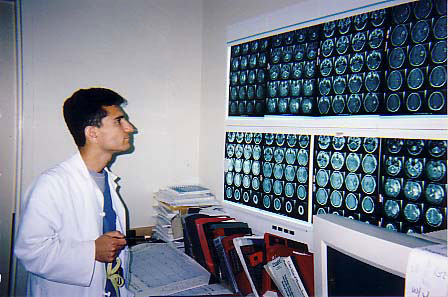July 26, 2004

Babak Kateb
NASA Infrared Camera Helps Surgeons Map Brain Tumors July 15, 2004 NASA RELEASE -- Using an infrared video camera
developed by scientists at NASA's Jet Propulsion Laboratory (JPL)
in Pasadena,
Calif., surgeons are
testing thermal imaging and image processing to see if they can
create useful maps of brain tumors.
Researchers want to see if the camera, which detects infrared,
or heat, emissions, might help neurosurgeons better visualize tumors
before they operate and also find tiny clusters of cancerous cells
that might remain after surgery.
NASA scientists already may use infrared technology to map Earth's
surface and search for distant objects in the universe. Firefighters
use it to locate people trapped in buildings, and military forces
track down their targets hiding in the dark.
Physicians have used infrared technology for mapping the roots
of skin cancer, but it's never been used for brain tumors until
now.
Doctors at the Keck School of Medicine of the University of Southern
California (USC) in Los Angeles are using the JPL-developed camera
and infrared imaging in a trial. They're trying to see if they
can sketch tumor margins by detecting temperature changes during
surgery, since tumor cells emit more heat than healthy ones. "The
camera's precision allows it to map temperature differences of
one-hundredth of a degree Celsius at a high resolution," said
Dr. Sarath Gunapala, JPL lead engineer for the camera.
Currently, neurosurgeons delve carefully into the brain and remove
as much of the tumor as they can see under magnification. However,
they may take healthy tissue along with the cancerous cells or
leave residual cells that can grow back along the tumor's margins.
" Brain tumor tissue looks the same as healthy tissue on
the edges," said Babak Kateb of the Keck School of Medicine,
a research fellow and lead scientist of the project. "Tumor
cells use different biochemical pathways from normal cells, and
when researchers use the infrared camera, they can pick up hotspots
or areas of tissue warmer than normal tissue," he added.
After doctors receive infrared images of the brain, imaging-processing
software marks the boundaries between tumor regions and surrounding
healthy tissue. "We are refining software similar to what
our group has been using for analyzing rocks on Mars and other
planets," said Dr. Wolfgang Fink, JPL senior researcher.
"An advantage of thermal imaging is that it's non-invasive," said
Dr. Peter Gruen, a neurological surgeon at the Keck School of Medicine. "It
measures heat energy emerging from patients without exposing them
to X-rays or intravenous solutions, and is performed without incisions
or contact to the brain tissue," he added.
A clinical study of this proposed mapping process is underway
at the Keck School of Medicine.
This is another example of the great benefits of transferring
NASA-developed technology for the public good.
For more information on the USC study on the Internet, visit:
//www.usc.edu/schools/medicine/ksom.html
For more information on the infrared camera on the Internet,
visit:
//www.jpl.nasa.gov/technology/features/tech930.html
For more information on NASA spinoffs on the Internet, visit:
//www.sti.nasa.gov/tto
For more information about NASA on the Internet, visit:
//www.nasa.gov
*
*
Who's your Iranian of the day?
Send us
photo
|